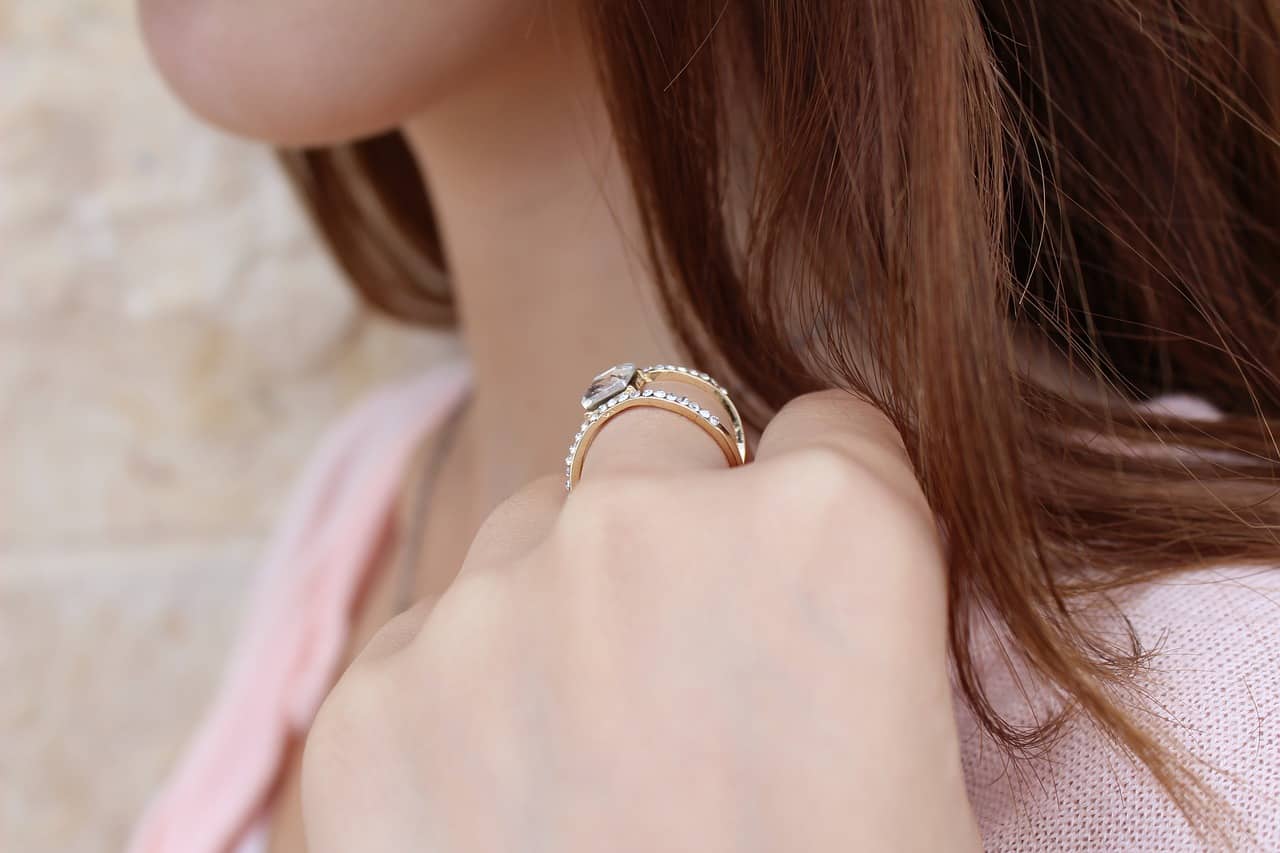
Table of Contents
As Jewelry Shopping Guide editors, we write about things that we love and we think you’ll like too. We often have affiliate partnerships, and may generate some revenue from these links at no cost to you.
Diamond color in colorless diamonds might sound like a contradiction in terms. But if you know anything about diamonds, then you probably know that color is one of the most important factors to consider when choosing one. As one of the famous 4Cs (cut, color, clarity, carat), color affects the beauty and value of a diamond.
Understanding diamond color is critical if you want to get the best deal on your diamond. In this article, we cover everything you need to know about diamond color before you buy.
We have used examples from the James Allen site as they provide clear images/videos of their diamonds, a necessity when examining diamond color.
What’s the Diamond Color Chart?
The diamond color chart was devised by the Gemological Institute of America (GIA) as a way to grade diamonds systematically based on the extent of the color they exhibit. The GIA’s grading system is accepted around the world as the standard.

The diamond color chart begins at D and goes all the way Z, slowly increasing in color from perfectly colorless to noticeably yellow. Although these diamonds have varying levels of tints, they are all still considered colorless diamonds and not colored diamonds.
Diamonds with color grades beyond Z then enter the territory of Fancy Yellow Colored Diamonds. As the yellow increases, the diamond picks up value again, with Fancy Vivid Yellow Diamonds considered very valuable. This however is graded on a separate scale and not connected to the white diamond category.
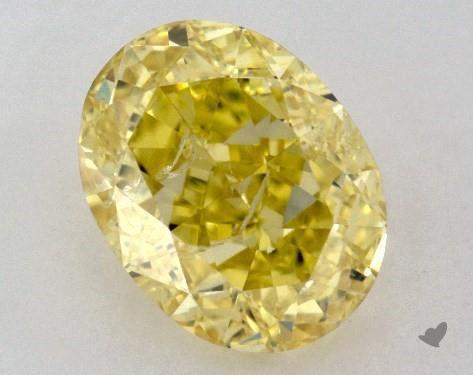
When they’re being graded, diamonds are compared to a master set in a carefully constructed environment to reduce distractions that may affect the grading process.
An important point to note is that diamonds are graded for the absence of color and not for the presence of color. Taking this into consideration, diamond color is not a rigid phenomenon but rather a factor that is easily influenced by factors that interact with it, such as the setting, light, shape and so on. This is a fluid concept so you can’t really take it on face value.
Just because a diamond is graded J, for example, doesn’t mean that it will always show strong, noticeable color. Case in point is this diamond from Brian Gavin. At first glance, it appears perfectly colorless! However, it is a J grade diamond, which some pundits will tell you to steer clear from.
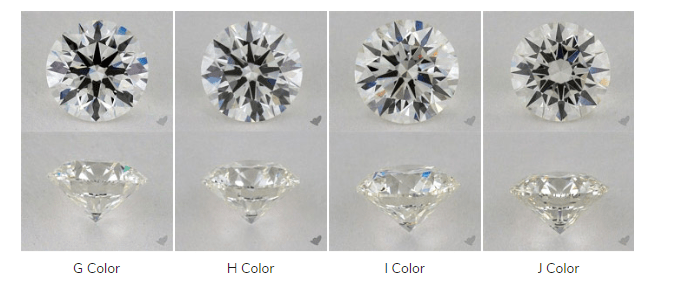
When viewed face up, diamonds often appear more colorless than they actually are. However, the side view of diamonds tends to show more color. What this means is that once the diamond is mounted in a ring setting, it will be very difficult to see that color, as you would be mainly seeing it from the top view.
Here’s a quick break down of the differences between the color grades:
- Colorless Grades – D-E-F
These are the most expensive and the rarest of the diamonds due to the absence of color within them. While the D grade is considered superior and perfectly colorless, there is little difference to the naked eye between these three grades. Only a gemologist with special tools would be able to distinguish between these.
Colorless Grades are for those who want a ‘perfect’ diamond or who don’t really have a restriction on their budget.
- Near Colorless – G-H-I-J
These diamonds look colorless when viewed face-up but show slight yellow tints when viewed from side angles. The near colorless range of diamonds are god value for money as they show little to no perceptible color when mounted in their jewelry settings, but come at a great price due to their being lower down on the color scale.
The Near Colorless diamonds offer the best value and are ideal if you want to save on your diamond without compromising on the look.
- Noticeable Faint Color – K-L-M
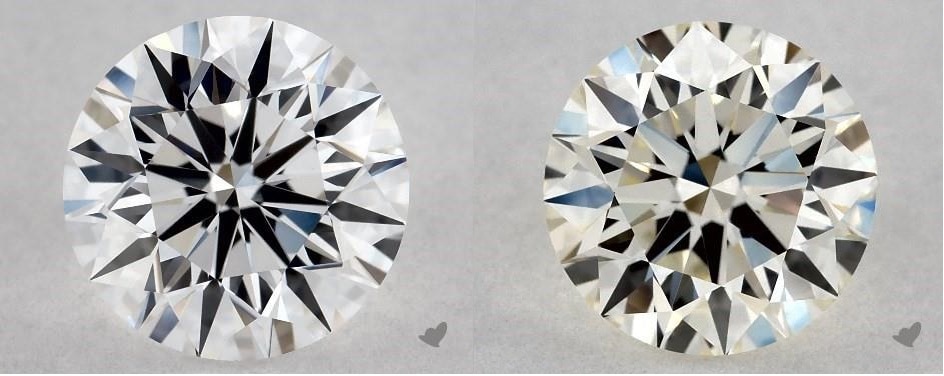
Diamonds in the Faint Color range have noticeable color, visible even in yellow gold settings face up. These diamonds are ideal for those who are after a stone with warm tints and who like the look of a soft sun-touched diamond. Many retailers don’t sell diamonds below M grade as they are considered of low quality.
What’s the Correlation between Diamond Value and Color?
Color is one of the main factors that affects the price of a diamond. The general rule of thumb is that the less color the diamond exhibits, the more valuable it is. Each subsequent color grade is lower in value than the one before it. Even though there may be no noticeable difference to the naked eye between two color grades, there will be a difference in price, all else being equal.
For the sake of comparison, take a look at this D grade diamond compared to this E grade one. The two diamonds look very similar in appearance but the difference in price is quite high! While there are other factors that contribute to this disparity in value in these two diamonds, such as cut specifications, the color would be a significant one.
For the consumer, this means that you can purchase a beautiful looking diamond at a good price if you drop your color grade down as low as you can go. Why pay extra for a feature you probably will not be able to see?
How Can the Ring Setting Affect Diamond Color?
When diamonds are graded, they are placed in a white background and carefully observed for any traces of color. In this sort of environment, color is more noticeable. But in the real world, the diamond isn’t subject to such meticulous scrutiny.
Once the diamond is placed in a setting, the color is much harder to see. The color of the setting largely influences how the diamond appears and can add to or detract from the diamond’s original color. Case in point is the diamond below set in two different colored settings.
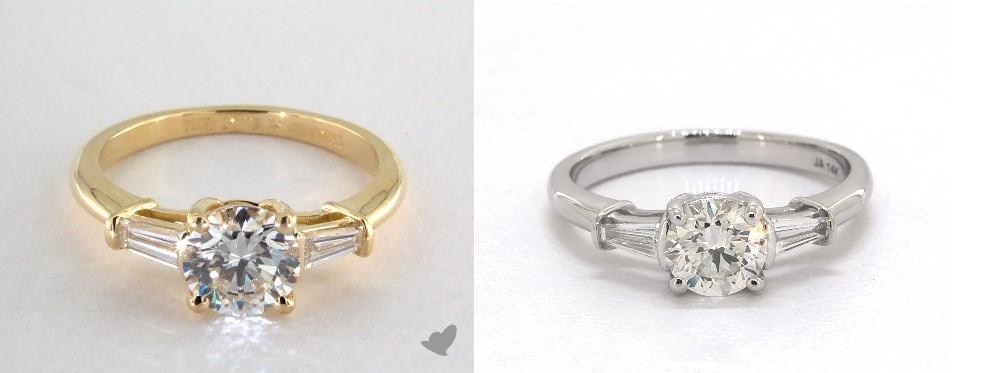
The same diamond appears different based on the setting color. Set in yellow gold, the G diamond looks whiter whereas when set in white gold, the yellow tints are more pronounced.
While on the subject of settings, we need to clarify that it is not the color of the entire setting that affects the diamond but rather the part that holds the stone, namely the prongs and the basket (if there is one). It is this part of the setting that will reflect through the diamond, affecting its color.
Colorless diamonds (D-E-F) should generally be set in silver-hued settings to accentuate their whiteness. However, you can drop the color grade if you’ve opted for a yellow gold setting. We recommend Nearly Colorless grades for white settings and J-M grades for yellow gold for the best value.
Remember that these are just guidelines and that you really need to evaluate diamonds on a case by case basis. In many cases, setting a lower color grade diamond in a white gold or platinum setting can make it appear whiter.
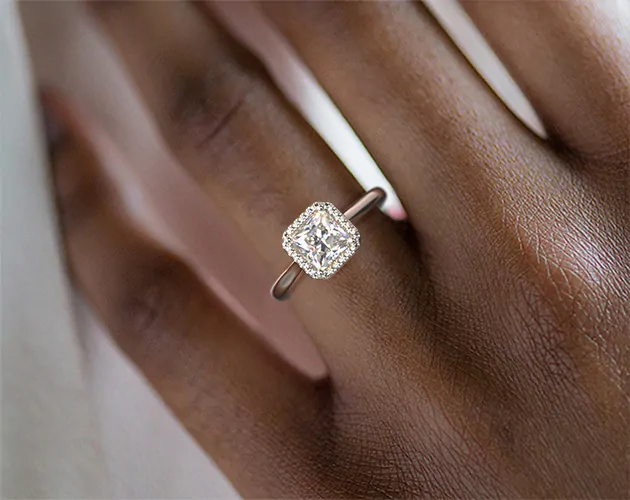
Diamond Color and Diamond Size
If you’re buying a large diamond, it’s best not to compromise too much on color as tints are more likely to be visible on bigger stones. The larger the diamond, the easier it is to notice color.
If you take two diamonds of the same color grade but of different sizes and place them side by side, you’ll notice that the larger stone will show more color than the smaller one.
For a stone under .50 carats, you could drop down to the J-K grades and still have a fairly colorless gemstone. However, for stones over 2 carats, it’s wiser to stick to H or better to avoid yellowish tints being visible.
The Relationship Between Diamond Color and Shape
The shape of the diamond can help to mask any yellow tints it may show. In general, cuts with many facets which are highly brilliant are good at hiding color. This is also the reason why brilliant cuts aren’t the best when it comes to colored diamonds as they don’t bring out the color of the diamond as desired.
The round brilliant cut is the most popular shape when it comes to diamonds and it is also the best in terms of minimizing color tints in a diamond. Because of its many facets and high sparkle, the round brilliant cut tends to mask color, overpowering it with sparkle instead.
This is why cut quality is an important factor as it can make or break your diamond. If the diamond has been expertly cut and the brilliance of the stone is high, this can mask many faults the diamond may have such as clarity and color.

Most fancy shapes aren’t the best choice if masking color is your intention. Certain shapes such as the step cuts (emerald and Asscher) or fancy long shapes like marquise, oval and pear cuts, tend to show color quite obviously. Because of this, it’s best not to compromise on color if you’re picking a fancy shape.
How Blue Fluorescence Affects Color – in a Good Way
Another factor that has an impact on color is fluorescence. Fluorescence is a largely misunderstood phenomenon in the diamond industry and there are many myths associated with it. When it comes to color, fluorescence can be an advantage.
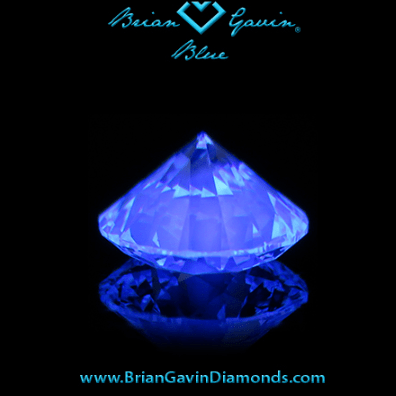
Fluorescence refers to the colored glow that a diamond gives out when exposed to ultraviolet (UV) rays. It is the degree or intensity of the diamond’s reaction to these rays. This reaction can vary from very strong to none.
For colorless diamonds, medium to strong fluorescence may make the stone appear hazy. However, for diamonds lower on the scale (I to M grades) fluorescence can cause them to appear whiter. Because yellow and blue are complementary colors, blue fluorescence emitting from a yellowish diamond tends to neutralize the yellow color and give the stone a more colorless appearance.
The Bottom Line…
There is no magic color grade that works for everyone. Choosing the best grade for you depends on factors such as the cut and shape of the diamond, the color of the setting and your personal preferences.
But don’t go by the grade alone. Ensure that you see the actual diamond clearly, either in person or via HD videos and images. Color in colorless diamonds can be a tricky thing but with careful evaluation, you will be able to find a stunning diamond at a great price.
Online Stores We Recommend
If you’re purchasing your diamond online, it’s best not to compromise on the quality of the vendor. The below retailers are known for their presence in the industry, quality and service.
James Allen
With stunning 360 degree video of impeccable quality, viewing rings and diamonds on James Allen is the next best thing to seeing it in person. James Allen has an impressive range diamonds from D to M grades. Browse their massive diamond inventory here.
Blue Nile
Blue Nile has the largest online inventory of diamonds at competitive prices. They’re known for their quality and great customer service. See their range here.
Brian Gavin
Brian Gavin’s diamonds are famous for their cut quality and for their continuous innovation in perfecting their cut quality. Their Black and Blue Collections feature some of the very best diamonds. See their range here.









